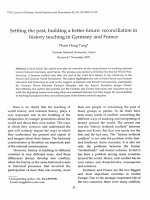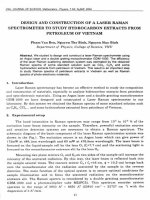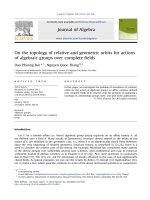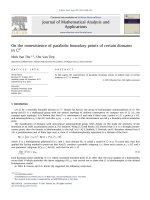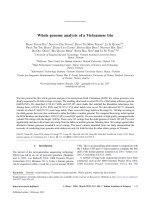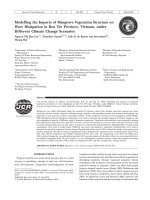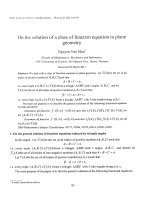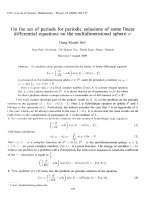DSpace at VNU: Determining the deflection of a thin composite plate in an unsteady temperature field
Bạn đang xem bản rút gọn của tài liệu. Xem và tải ngay bản đầy đủ của tài liệu tại đây (470.74 KB, 8 trang )
Mechanics of Composite Materials, Vol. 48, No. 3, July, 2012 (Russian Original Vol. 48, No. 3, May-June, 2012)
DETERMINING THE DEFLECTION OF A THIN COMPOSITE
PLATE IN AN UNSTEADY TEMPERATURE FIELD
Nguyen Dinh Duc*1 and Nghiem Thi Thu Ha2
Keywords: composite plate, buckling, unsteady heat transfer, PVC, titanium particles
The buckling behavior of a thin particle-reinforced composite plate under the influence of an unsteady
temperature field and a temperature gradient across its thickness is investigated. An analytic solution for bending
of the plate is obtained in the form of double trigonometric series. Based on the analytic result, a numerical
test is carried out to study the thickness and time dependences of the buckling behavior of a plate made of a
PVC matrix and titanium particles.
1. Introduction
In recent years, the behavior of plates under thermal loadings has been investigated by many authors. In [1], the thermal
buckling of rectangular composite multilayered plates with temperature-dependent material properties was studied by using
a layerwise plate theory. Their buckling temperature was determined, and the influence of various mechanical and geometric
parameters of the plates on the buckling temperature was investigated. In [2], the finite-element method was used to investigate
the thermal buckling behavior of composite laminated plates in detail. In [3], the first-order shear deformation theory was
employed to derive the equilibrium and stability equations for a simply supported moderately thick rectangular plate, made of
a functionally graded material, under two thermal loadings. The buckling temperature was determined, and the influence of
the aspect ratio of particles, of the relative thickness of layer, and of the gradient index and transverse shear on the buckling
temperature was investigated. In [4, 5], the thermal buckling of rectangular functionally graded plates is analyzed. In [4], the
authors investigated a plate under partial heating in its plane and examined the effects of material inhomogeneity, aspect ratio,
and heated region on the critical buckling temperature. In [5], by using the classical plate theory, the equilibrium, stability,
University of Engineering and Technology, Vietnam National University, Hanoi
University of Science, Vietnam National University, Hanoi
*
Corresponding author; e-mail:
1
2
Russian translation published in Mekhanika Kompozitnykh Materialov, Vol. 48, No. 3, pp. 437-448 , May-June,
2012. Original article submitted December 28, 2011.
0191-5665/12/4803-0297 © 2012 Springer Science+Business Media, Inc.
297
and compatibility equations are derived for an imperfect functionally graded plate under three types of thermal loading, and
closed-form solutions for the critical buckling temperature are found.
In this paper, we investigate the deflection of a rectangular composite plate, made of PVC and titanium particles,
subjected to the action of an unsteady heat transfer through its thickness. Note that the problem of unsteady heat transfer for a
composite engineering tube was investigated in [6]. Here, we assume that material components are homogenous and isotropic.
In [7], we determined the elastic moduli of a particle-reinforced composite, and in [8] ― the coefficient of the thermal
expansion of a composite material as a function of properties of its components and their volume fractions. Here, we employ
formulas for the elastic moduli of composites that take into account the interaction between the matrix and particles [7]:
K = Km +
( Kc − K m ) ξ
1 + ( Kc − K m )
4
K m + 3 Gm
,
G = Gm −
15 (1 −ν m ) ( Gm − Gc ) ξ
.
Gc
7 − 5ν m + ( 8 − 10ν m )
Gm
The coefficient of thermal expansion of a particle-reinforced composite was determined in [8]:
α = α m + (α c − α m )
K c ( 3K m + 4Gm ) ξ
K m ( 3K c + 4Gm ) + 4 ( K c − K m ) Gmξ
,
N
where ξ = ∑ Vi V is the volume fraction of the particles; Gm , Gc , K m , K c , ν m , and ν c are the shear moduli, bulk modi =1
uli, and Poission ratios of the matrix and particles, respectively.
2. Governing Equations
Since the heat transfer through the thickness of the plate is unsteady, the heat conduction equation is [9]
The initial and boundary conditions are
∂T
∂ 2T
= a1 2 . (1)
∂t
∂z
T − Ti = 0
at t = 0,
∂
T
h
= β1 (T − T1 ) at z = − , (2)
k
2
∂z
∂T
h
−k ∂z = β 2 (T − T2 ) at z = 2 ,
k
is the thermal diffusivity of plate material; T1 and β1 are the ambient temperature and the convective heat
Cρ
transfer coefficient, respectively, at z = −h 2 ; T2 and β 2 are the ambient temperature and the convective heat transfer coefficient, respectively, at z = h 2 ; k , C , and ρ are the coefficient of thermal conductivity, the specific heat, and mass density,
which are assumed in the form [6]
where a1 =
k = (1 − ξ ) km + ξ kc , ρ = (1 − ξ ) ρ m + ξρc , C =
Cm ρ m (1 − ξ ) + Cc ρcξ
ρ m (1 − ξ ) + ρcξ
.
The strains of the plate are [10, 11]
exx =
∂u
∂v
∂2 w
∂2 w
1 ∂u ∂v
∂2 w
. (3)
− z 2 , e yy =
− z 2 , exy =
+ − z
∂x
∂y
2 ∂y ∂x
∂x∂y
∂x
∂y
where, u , v , and w denote the displacements of its midplane points along the x , y , and z axes, respectively.
298
Hooke’s law for the stress–strain relationship at a varying temperature is [9]
σ xx =
E
1 −ν 2
( exx +ν eyy − (1 +ν )α∆T ) ,
σ xy =
σ yy =
E
1 −ν 2
( eyy +ν exx − (1 +ν )α∆T ) , (4)
E
exy .
1 +ν
Inserting (3) into (4), we get the relations between stresses and displacements
σ xx =
∂u
∂2w
∂v
∂2w
− z 2 + ν 2 − α∆T ,
+ν
∂x
∂y
1 −ν ∂x
∂y
σ yy =
∂v
∂2 w
∂u
∂2 w
− z 2 + ν 2 − α∆T ,
+ν
∂y
∂x
1 −ν ∂y
∂x
E
2
E
2
σ xy =
∂u ∂v
E
∂2 w
+ − 2z
.
∂x∂y
2 (1 + ν ) ∂y ∂x
The moments and membrane forces are
Eh ∂u
∂v NT
Eh ∂v
∂u NT
Eh ∂u ∂v
+ν
, Ny =
+ν
, N xy =
+ , (5)
−
−
2
2
∂y 1 −ν
∂x 1 −ν
2 (1 + ν ) ∂y ∂x
1 −ν ∂x
1 −ν ∂y
Nx =
∂2 w
∂2 w
∂2 w
∂2w M
∂2 w M
M x = − D 2 + ν 2 − T , M y = − D 2 + ν 2 − T , M xy = − D (1 −ν )
, (6)
∂x
∂y
∂x∂y
∂y 1 −ν
∂x 1 −ν
where
h2
NT = α E
∫
∆Tdz , M T = α E
−h 2
h2
∫
z ∆Tdz , D =
−h 2
Eh3
(
12 1 −ν 2
)
. (7)
The basic equations for determining the deflection of the plate are the equilibrium equations [10]
∂N x ∂N xy
+
= 0,
∂x
∂y
∂2 M x
∂x 2
+2
∂ 2 M xy
∂x∂y
+
∂2 M y
∂y 2
+ Nx
∂N xy
∂x
∂2 w
∂x 2
+
∂N y
∂y
+ 2 N xy
= 0,
(8)
∂2 w
∂2 w
+ N y 2 = 0.
∂x∂y
∂y
3. Deflection of a Simply Supported Plate
Let
τ=
a1t
h
2
, ζ =
βh
z
, γ1 = 1 ,
h
k
γ2 =
β2 h
;
k
then Eq. (1) becomes:
∂T ∂ 2T
(9)
=
∂τ ∂ζ 2
299
with the initial and boundary conditions
T =T
at τ = 0,
i
∂T
1
= γ 1 (T − T1 ) at ζ = − , (10)
2
∂ζ
∂T
1
= γ 2 (T − T2 ) at ζ = .
−
2
ζ
∂
Using the Laplace transformation
∞
T * = ∫ Te − pτ dτ ,
0
Eqs. (9) and (10) are put into the form
d 2T *
dζ
T
− p T * − i = 0 ,(11)
p
dT *
T
1
− γ 1 T * − 1 = 0 at ζ = − ,
2
p
dζ
(12)
*
1
dT + * − T2 0 at
ζ = .
=
dζ γ 2 T
2
p
The solution of Eq. (11) is
2
T* =
Ti
+ D1 cosh pζ + D2 sinh pζ ,
p
where D1 and D2 are determined from boundary conditions (12).
Introducing T * into (12), we obtain
T* =
Ti A ( p )
+
,
p B ( p)
where
1
1
γ
A( p ) = γ 1 (T1 − Ti ) cosh p − ζ + 2 sinh p − ζ
p
2
2
1
1
γ
+ γ 2 (T2 − Ti ) cosh p + ζ + 1 sinh p + ζ
p
2
2
,
sinh p
B ( p ) = p ( p + γ 1γ 2 )
+ ( γ 1 + γ 2 ) cosh p .
p
The solution of Eq. (1) with conditions (2) is found in the form
where
300
T = Ti +
( )
( )
2
A ( 0 ) ∞ A − µn − µn2τ
+∑
e
,
B ′ ( 0 ) n =1 B ′ − µn2
1
A ( 0 ) = γ 1 (T1 − Ti ) 1 + γ 2 − ζ
2
1
+ γ 2 (T2 − Ti ) 1 + γ 1 2 + ζ
B ′ ( 0 ) = γ 1 + γ 2 + γ 1γ 2 ,
,
1
1
γ
A − µn2 = γ 1 (T1 − Ti ) cos µn − ζ + 2 sin µn − ζ (13)
2
2
µn
(
1
+γ 2 (T2 − Ti ) cos µn + ζ
2
)
(
)
B ′ − µn2 = −
1
γ1
+ µ sin µn 2 + ζ ,
n
{
(
)
}
1
(1 + γ 1 + γ 2 ) µn2 + γ 1γ 2 sin µn + µn2 − γ 1γ 2 µn cosµn ,
2µn
and µn = i pn +1 is the solution of the equation
tan µ =
γ1 + γ 2
µ 2 − γ 1γ 2
µ.
Let T0 = Ti ( T0 is the absolute temperature in natural conditions); then
∆T =
( )
( )
2
A ( 0 ) ∞ A − µn − µn2τ
+∑
e
, (14)
B ′ ( 0 ) n =1 B ′ − µn2
where A(0), B ′(0), A(− µn2 ), and B ′(− µn2 ) are determined as in (13). We assume that the midplane is free of strains; then
(5) becomes
N
N
N x = − T , N y = − T , N xy = 0. (15)
1 −ν
1 −ν
Inserting DT (determined from (14)) into the expressions of NT and M T into (7), integrating them, and considering
N=
N 0 and M T = M 0 . With the forces and moments found and Eqs. (6) inserted into Eqs. (8),
Eqs. (15), we get that N=
x
y
the first two equations are satisfied automatically, but the third one takes the form
N
D∇ 2 ∇ 2 w − N 0 ∇ 2 w = 0, or ∇ 2 ∇ 2 w − 0 w = 0. (16)
D
The boundary conditions of a simply supported plate are
∂2w
∂2w M
w = 0, M x = − D 2 + ν 2 − 0 = 0,
∂x
∂y 1 −ν
at x = 0 and x = a,
∂2 w
∂2w M
w = 0, M y = − D 2 + ν 2 − 0 = 0,
∂y
∂x 1 −ν
at y = 0 and y = b.
Equation (16) can be rewritten as
∂ 2
∂2
2 + 2
∂y
∂x
2
∂2
∂
+
2
∂y 2
∂x
f = 0,
N0
w= f.
w −
D
(17)
On the other hand, we can consider the boundary conditions
w = 0,
w = 0,
∂2 w
∂y 2
∂2 w
∂x 2
= 0,
at x = 0 and x = a,
(18)
= 0,
at y = 0 and y = b.
301
Thereby, using boundary conditions (18), we obtain the boundary conditions for the unknown function f
f+
M0
=0
D (1 −ν )
at x = 0 and x = a ,
f +
M0
=0
D (1 −ν )
at y = 0 and y = b .
From these equations, we find the unknown function f appearing in the first equation of system (17):
f =−
M0
,
D (1 −ν )
The second equation of system (17) becomes
∂2
∂2
2 + 2
∂y
∂x
N0
M0
,(19)
w=−
w −
D
D (1 −ν )
which is used for determining the deflection w of the plate in the case of unsteady heat transfer. The boundary condition w = 0
is satisfied if w is expressed in the Fourier series [11]:
w=
∞
∞
∑ ∑ wmn sin
m =1 n =1
nπ y
mπ x
sin
,(20)
b
a
where m and n are natural numbers. We also express M 0 in a Fourier series:
M0 =
where
Inserting (20), (21) into Eq. (19), we get
wmn
∞
m =1 n =1
nπ y
mπ x
sin
,(21)
b
a
16 M 0
if m, n = 1, 3, 5...,
amn = π 2 mn
0
if m, n = 2, 4, 6,....
∞
∑ ∑ amn sin
1
amn
D 1 −ν . 2 2
) m π + n 2π 2 + N 0
(
=
D
a2
b2
0 if m, n = 2, 4, 6....
if m, n = 1, 3, 5,...,
Thus, the analytic solution for the deflection of the plate under the conditions of unsteady heat transfer is
w=
amn
1
nπ y
mπ x
⋅ 2 2
sin
.
sin
2 2
a
b
N0
nπ
m =1,3,5,... n =1,3,5,... D (1 −ν ) m π
+ 2 +
D
a2
b
∑
∑
This is a familiar solution form of the buckling problem of plates; however, unlike the known results, its coefficients
are determined from geometric parameters of the plate, the properties and volume fractions of material components, and the
parameters of the unsteady heat transfer process.
302
w, mm
3.0
2.0
1
1.0
3
2
0
4
-1.0
-1.5
x, m
0
0.5
1.0
1.5
2.0
2.5
Fig. 1. Deflection w of the plate along its length at t = 1200 s and ξ = 0.1 (1), 0.15 (2), 0.21 (3), and
0.3 (4).
w, mm
0.10
0.05
x=0.3
0
x=0.2
-0.05
-0.10
-0.15
-0.20
-0.25
t, s
0
400
800
1200
1600
Fig. 2. Deflection w at the midpoint of the plate according to time t.
4. Numerical Result
To study a specific case, we considered a composite plate containing titanium particles, whose material components
had the following characteristics [6, 8].
PVC matrix: Em = 3 GPa, ν m = 0.2 , α m = 8 ⋅10−5 /K, km = 0.16 W/(m · K), Cm = 900 J/(kg · K), and
ρ m = 1380 kg/m3.
Titanium particles: Ec = 100 GPa, ν c = 0.34 , α c = 4.8 ⋅10−6 /K, kc = 22.1 W/(m · K), Cc = 523 J/(kg · K), and
ρc = 4500 kg/m3.
The plate had a length a = 2.25 m, width b = 1.5 m, and thickness h = 0.02 m. The surrounding medium was air with
β1 = 60 W/(m2 · K) and T1 = 330 K at z = − h 2 and T2 = 300 K, β 2 = 40 W/(m2 · K), and T0 = 293 K at z = h 2 .
Inserting these data into the expression determining the deflection of the plate and using Matlab 7.1 for calculation,
the results shown in Figs. 1 and 2 were obtained.
As seen from Fig. 1, the volume fraction ξ of titanium particles has a significant effect on the bending behavior of the
plate. At ξ = 0.1, the deflections are positive and vary greatly along the plate. At ( 0.1 < ξ ≤ 0.2 ), the deflections are smaller
and vary more uniformly when the volume fraction of the particles is increased. When ξ reaches the value 0.3, the deflections
303
and their differences at various points along the plate increase. From Fig. 2, we notice that, at the beginning, the deflection of
the plate varies continuously with time, but at certain periods of time, the deflection of the plate at the midpoint remains almost
unchanged.
5. Conclusion
The results obtained show that, at a suitable volume content, the reinforcing titanium particles allows one to increase
the bending resistance and thermal stability composite plates.
Acknowledgment. This work was financially supported by Project 107. 02 — 2010. 08 of the National Foundation for
Science and Technology Development of Vietnam — NAFOSTED. The authors are grateful for this support.
References
1. M. Shariyat, “Thermal buckling analysis of rectangular composite plates with temperature-dependent properties based
on a layerwise theory,” Thin-Walled Structures, 45, 439-452 (2007).
2. L. C. Shiau, S. Y. Kuo, and C. Y. Chen, “Thermal buckling behavior of composite laminated plates,” Composite Structures, 92, 508-514 (2010).
3. Wu Lanhe, “Thermal buckling of a simply supported moderately thick rectangular FGM plate,” Composite Structures,
64, 211-218 (2004).
4. T. Morimoto, Y. Tanigawa, and R. Kawamura, “Thermal buckling of functionally graded rectangular plates subjected
to partial heating,” Int. J. of Mechanical Sciences, 48, 926-937 (2006).
5. B. A. Samsam Shariat and M. R. Eslami, “Thermal buckling of imperfect functionally graded plates,” Int. J. of Solids
and Structures, 43, 4082-4096 (2006).
6. Nguyen Dinh Duc, Nguyen Thi Thuy, “A composite cylinder under an unsteady, axisymmetric, plane temperature
field,” J. of Science (Mathematics Physics ) of Vietnam National University, 26, 83-92 (2010).
7. G. A. Vanin and Nguyen Dinh Duc, “The theory of spherofibrous composites. 1. Input relations, hypotheses, and models,” J. Mechanics of Composite Materials, 32, 291-305 (1996).
8. Nguyen Dinh Duc, Hoang Van Tung, and Do Thanh Hang, “An alternative method for determining the coefficient of
thermal expansion of composite material with spherical particles,” Vietnam Journal of Mechanics, VAST, 29, No. 1,
58-64 (2007).
9. A. D. Kovalenko, Foundations of Thermoelasticity, Kiev, Naukova Dumka (1970).
10. T. Timoshenko and S. Krieger, Theory of Plates and Shell, Mc Graw-Hill Book Company, N. Y. (1959).
11. D. O. Brush and B. O. Almorth, Buckling of Bars, Plates, and Shells, Mc Graw-Hill, N. Y. (1975).
304
